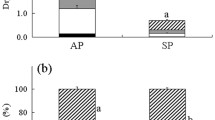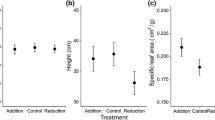Summary
The periodic occurrence of summer/early autumn precipitation in the California annual grassland can result in the formation of early and late emerging cohorts of Erodium botrys and E. brachycarpum. The occurrence of early rainfall and the timing of such rainfall are highly variable from year to year. A series of field watering experiments in 1980–81 were used to simulate early emergence conditions that would result from significant rainfall (1 cm) occurring in mid-July, late August, and mid-September. Net reproduction was used to estimate fitness differentials between Erodium cohorts emerging in response to a watering treatment (early emerging cohorts) and Erodium cohorts emerging with the onset of winter rains in mid-October (late emerging cohorts). Survival was lower and gross reproduction was higher among early emerging cohorts than late emerging cohorts. For both species, net reproduction of the early cohort was lower than that of the late cohort under the July watering treatment and higher than that of the late cohort under the August watering treatment.
Early cohorts, formed in response to rainfall in mid-September, 1982, were also compared demographically to later cohorts emerging in October. Compared to late cohorts, net reproduction, gross reproduction and survival were higher for the early cohorts.
Common garden experiments indicate that differences in the duration of seed dormancy between the progenies of early and late emerging plants reflect a significant genetic component. Progency produced by early cohorts of E. brachycarpum from all three watering treatments possessed more extended seed dormancy than progeny of late cohorts. In E. botrys, progeny from early cohorts emerging in response to the July watering treatment were also more dormant than late progeny. In contrast, early cohorts of E. botrys emerging in response to the September watering treatment produced seed less dormant than seed produced by late cohorts. When combined with demographic data, indicating that fitness differentials between early and late cohorts varied with changes in the date of early emergence, genetic results suggest that year to year variation in early rainfall may act to retain genetic variation in the duration of seed dormancy.
Similar content being viewed by others
References
Arthur AE, Gale JS, Lawrence MJ (1973) Variation in wild populations Papaver dubium. VII. Germination time. Heredity 30:189–197
Bartolome JW (1976) Early rains alter range forage. Calif Agric 30:14–15
Bartolome JW (1979) Germination and seedling establishment in California annual grassland. J Ecol 67:273–281
Baskin JM, Baskin CC (1972) Influence of germination date on survival and seed production in a natural population of Leavenworthia stylosa. Am Midl Nat 88:318–323
Black JN, Wilkinson GN (1963) The role of time of emergence in determining the growth of individual plants in swards of subterranean clover. Aust J Agric Res 14:628–638
Bryant EH (1976) A comment on the role of environmental variation in maintaining polymorphisms in natural populations. Evolution 30:188–190
Cook RE (1980) Germination and size-dependent mortality in Viola blanda. Oecologia (Berlin) 47:115–117
Cook RE, Lyons EE (1983) The biology of Viola fimbriatula in a natural disturbance. Ecology 64:654–660
Edwards M (1980) Aspects of the population ecology of charlock. J Ecol 17:151–171
Garbutt K, Witcombe JR (1986) The inheritance of seed dormancy in Sinapsis arvensis L. Heredity 56:25–31
Gifford RO, Ashcroft GL, Magnuson MD (1967) Probability of selected precipitation amounts in the western region of the United States. Univ Nevada Agric Exp Sta Pub T-8, Reno
Gillespie J (1974) The role of environmental grain in the maintenance of genetic variation. Am Nat 108:831–836
Gillespie J, Langley CH (1974) A general model to account for enzyme variation in natural populations. Genetics 76:837–884
Gottlieb LD (1977) Genotypic similarity of large and small individuals in a natural population of the annual plant Stephanomeria exigua ssp. coronaria (Compositae). J Ecol 65:127–134
Guittonneau G-G (1972) Contribution al'etude biosystematique du genre Erodium L'Her dans le bassin mediterraneen occidental. Boissiera 20:1–154
Haldane JBS, Jayakar SD (1963) Polymorphism due to selection of varying direction. J Genetics 58:237–242
Harper JL (1977) Population biology of plants. Academic Press, London
Harper JL, McNaughton IH (1960) The inheritance of dormancy in inter- and intraspecific hybrids of Papaver. Heredity 15:315–320
Hartgerink AP, Bazzaz FA (1984) Seedling-scale environmental heterogeneity influences individual fitness and population structure. Ecology 65:198–206
Hilu KW, de Wet JM (1980) Effect of artificial selection on grain dormancy in Eleusine (Gramineae). Sys Bot 5:54–60
Howell N (1981) The effect of seed size and relative emergence time on fitness in a natural population of Impatiens capensis Meerb. (Balsaminaceae). Am Midl Nat 105:312–320
Jain SK (1982) Variation and adaptive role of seed dormancy in some annual grassland species. Bot Gaz 143:101–106
Jana S, Archarya SN, Naylor JM (1979) Dormancy studies in seed of Avena fatua. 10. On the inheritance of germination behavior. Can J Bot 56:1663–1667
Kalisz S (1986) Variable selection on the timing of germination in Collinsia verna (Scrophulariaceae). Evolution 40:470–491
Levene H (1953) Genetic equilibrium when more than one ecological niche is available. Am Nat 87:331–333
Leverich WJ, Levin DA (1979) Age-specific survivorship and reproduction in Phlox drummondii. Am Nat 113:881–903
Levins R (1968) Evolution in changing environments. Princeton University Press, Princeton
Marks M, Prince S (1981) Influence of germination date on survival and fecundity in wild lettuce Lactuca serriola. Oikos 36:326–330
Munz PA (1968) A California flora and supplement. University of California Press, Berkeley
New JK (1961) Biological flora of the British Isles. No 76 Spergula arvensis. J Ecol 49:205–215
Pitt MD, Heady HF (1978) Responses of annual vegetation to temperature and rainfall patterns in northern California. Ecology 59:336–350
Porter RH, Durrell M, Romm HJ (1947) The use of 2,3,5-tetrazolium chloride as a measure of seed germinability. Plant Physiol 22:149–159
Quinn JA, Colosi JC (1977) Separating genotype from environment in germination ecology studies. Am Midl Nat 97:484–489
Raguse CA, Young JA, Evans RA (1977) Germination of California annual range plants in response to a summer rain. Agron J 69:327–329
Rice KJ (1984) Plant life history variation and colonization dynamics in a variable environment: the population biology of two sympatric winter annuals, Erodium botrys (Cav.) Bertol. and E. brachycarpum (Godr.) Thell. (Geraniaceae). PhD dissertation. University of California Davis, California
Rice KJ (1985) Responses of Erodium to varying microsites: the role of germination cueing. Ecology 66:1651–1657
Solbrig OT (1981) Studies on the population biology of the genus Viola. II. The effect of plant size on fitness in Viola sororia. Evolution 35:1080–1093
Templeton AR, Levin DA (1979) Evolutionary consequenses of seed pools. Am Nat 114:232–249
Wagnon KA, Biswell MM (1943) Two types of broad-leaf Erodium in California. Madrono 7:118–125
Werner PA, Caswell H (1977) Population growth rates and age versus stage-distribution models for teasel (Dipsacus sylvestris Huds.). Ecology 58:1103–1111
White J, Harper JL (1970) Correlated changes in plant size and number in plant populations. J Ecol 58:467–485
Young JA, Evans RA, Kay BL (1975) Dispersal and germination dynamics of broadleaf filaree, Erodium botrys (Cav.). Bertol Agron J 67:54–57
Author information
Authors and Affiliations
Rights and permissions
About this article
Cite this article
Rice, K.J. Evidence for the retention of genetic variation in Erodium seed dormancy by variable rainfall. Oecologia 72, 589–596 (1987). https://doi.org/10.1007/BF00378987
Received:
Issue Date:
DOI: https://doi.org/10.1007/BF00378987




